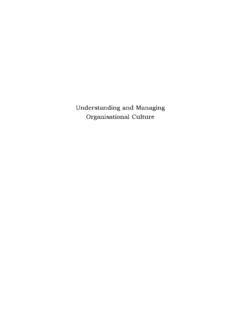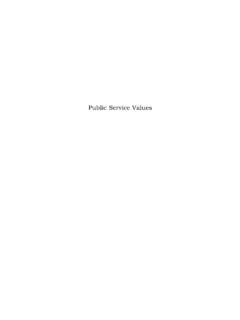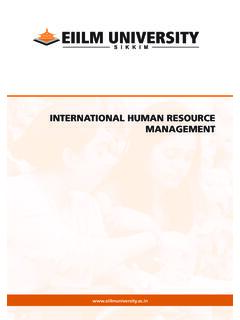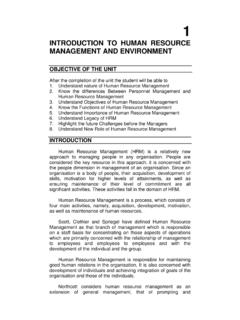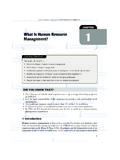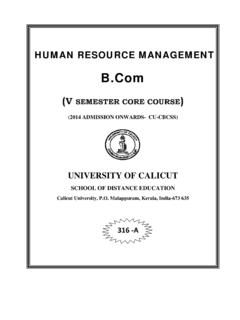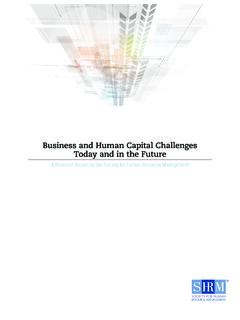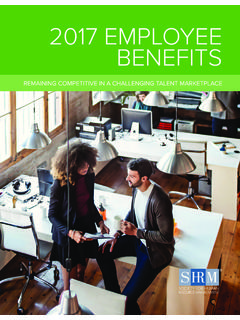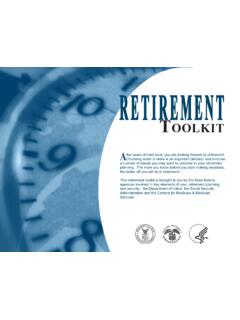Transcription of THE PRACTICE OF HUMAN RESOURCE MANAGEMENT
1 AN FORAS RIARACH ININSTITUTE OF PUBLIC ADMINISTRATIONJOANNA O RIORDANJULY 2017 THE PRACTICE OF HUMAN RESOURCE MANAGEMENTSTATE OF THE PUBLIC SERVICE SERIESRESEARCH PAPER 20 AN FORAS RIARACH ININSTITUTE OF PUBLIC ADMINISTRATIONJOANNA O RIORDANJULY 2017 STATE OF THE PUBLIC SERVICE SERIESRESEARCH PAPER 20 THE PRACTICE OF HUMAN RESOURCE MANAGEMENT2 THE PRACTICE OF HUMAN RESOURCE MANAGEMENTE xecutive Summary 41. Introduction 62. What is HRM? 73. Strategic HRM 104. The HR function 125. HR Systems and strategies 156. HR and performance 177. Conclusions 193 CONTENTS4 EXECUTIVE SUMMARY:This report provides an overview on HUMAN RESOURCE MANAGEMENT (HRM or frequently abbreviated to HR). The term first emerged in the 1980s in the United States. Against a backdrop of increased pressure on firms because of globalisation and technological developments, academics from a number of disciplines began to consider people and how they are employed and managed in organisations from a new perspective.
2 A convergence of this thinking evolved into what became known as HUMAN RESOURCE on the theoretical underpinnings of HRM in strategic MANAGEMENT and organisation behaviour, the goals of HRM have been identified as to (Armstrong and Taylor, 2015): Support the organisation in achieving its objectives by developing and implementing HR strategies that are integrated with business strategy Contribute to the development of a high-performance culture Ensure that the organisation has the talented, skilled and engaged people it needs Create a positive employment relationship between MANAGEMENT and employees and a climate of mutual trust Encourage the application of an ethical approach to people the 1990s, the term strategic HR became popular rather than simply HR. This is done to emphasise the objective of aligning HR policies and practices with the interests of the organisation more generally.
3 However, according to some commentators this has resulted in an imbalance across the many roles HR is expected to perform with a greater emphasis on being strategic and a business partner at the expense of being a people partner that actively engages with and listens to the needs and concerns of managers and employees in general. A perennial challenge for HR is the importance of showing that the application of good HR practices contributes to better organisation performance. The motivation has been to prove that HR rather than being a cost to the organisation adds value . Most of the research in this area is based on the premise that good HR practices enhance the motivation and commitment of staff which in turn impacts positively on productivity and performance. 5 JOAN RIJDIANSTNOEFRHN APSE IANFRHRUAFAHJThe Chartered Institute of Personnel and Development commissioned research (Purcell et al, 2003) to identify which HR practices appear to contribute most to improved productivity.
4 The six key work practices identified are: Career development and opportunities for advancement Training opportunities Job influence and challenge Involvement and communication Performance MANAGEMENT and appraisal processes Work-life , this and further research by Purcell and his colleagues (2007) found that good HR practices are not enough. What makes a bigger difference is the way people work together to be productive and flexible enough to meet new challenges (Purcell et al, 2003:32). This is facilitated by two key ingredients the approach to people MANAGEMENT taken by line managers and a positive organisation culture supported by strong, value-based leadership from senior MANAGEMENT . In many organisations HR is challenged by the multiple roles it is required to fulfil administrator, strategic partner, challenger, champion of good people MANAGEMENT , guardian of organisation values, conscience of the organisation and governor.
5 Achieving the right balance is dependent on HR investing in its own capacity and actively listening to the needs and concerns of managers and staff. Ultimately, there is no one best PRACTICE model of HR. The function within each organisation needs to build its approach based on a deep and evidence based understanding of the mission and culture of their organisation. 61. INTRODUCTIONH uman RESOURCE MANAGEMENT (HRM) emerged as a concept in the 1980s. Rebranding personnel MANAGEMENT quickly became popular, but many organisations had little awareness of the theory behind the report aims to provide a short and accessible overview of both the evolution of HUMAN RESOURCE MANAGEMENT (HRM) and current research in the area. The report explains the origins of HRM, examines issues in relation to HR functions, HR roles and HR strategies and addresses the ongoing debate around how HR impacts on organisation performance.
6 The report concludes by emphasising that good HR practices are not enough in themselves to improve employee commitment or build productivity in the organisation. Organisation culture, which is strongly influenced by the approach to leadership and MANAGEMENT in the organisation, is equally important. To be relevant HR needs to appreciate the varied and many roles it is required to fill and reflect on and develop its own capacity in respect of PRACTICE OF HUMAN RESOURCE MANAGEMENT72. WHAT IS HUMAN RESOURCE MANAGEMENT ? HUMAN RESOURCE MANAGEMENT (HRM, or sometimes abbreviated to HR) is concerned with all aspects of how people are employed and managed in organisations. The term HRM has largely taken over from that of personnel MANAGEMENT , which took over from previous terminology including labour or welfare MANAGEMENT . In the 1980s, against a backdrop of economic recession and increased pressures on firms because of globalisation and the accelerated pace of change brought about by technological developments, a number of academics began to think about people in organisations from a different perspective.
7 A combination of this thinking evolved into what became known as HUMAN RESOURCE MANAGEMENT . The conceptual framework of HRMThe question of how to achieve competitive advantage is the dominant concern of strategic MANAGEMENT . In the 1980s this came to particular prominence through the research of Michael Porter. A related economic theory, the RESOURCE -based view, which re-emerged at this time holds that competitive advantage is achieved if a firm s resources are valuable, rare and costly to imitate. Both these theories impacted on thinking in respect of people MANAGEMENT in , approaches and initiatives in respect of people MANAGEMENT should be consistent with the overall strategy of the organisation (Fombrun at al, 1984) and secondly, that all resources, but in particular HUMAN resources, contribute to the unique character of organisations and can therefore support competitive advantage.
8 This led to a recognition of people and investment in them as a source of HUMAN capital advantage (Boxall and Purcell, 2016) rather than a cost to be minimised as much as possible. The other side of the HRM concept emerged from organisation behaviour theory. Organisation behaviour (OB) is the study of how organisations function and how people behave in them. In other words, the interface between HUMAN behaviour and the organisation and how this impacts on the performance of the organisation. Areas of concern for HRM, including organisation design, organisation culture and leadership all have their roots in OB. However, most critical to the original concept of HRM are the areas of employee commitment and motivation, more recently described under the catch-all term of employee engagement. There are many definitions of HUMAN RESOURCE MANAGEMENT of varying degrees of complexity.
9 Two of the more meaningful are: HUMAN RESOURCE MANAGEMENT is a strategic, integrated and coherent approach to the employment, development and well-being of the people working in organisations (Armstrong, 2016:7) HUMAN RESOURCE MANAGEMENT is the process through which MANAGEMENT builds the workforce and tries to create the HUMAN performances that the organisation needs. (Boxall and Purcell, 2016:7)8 These definitions point to some of the key characteristics of HRM as identified by Armstrong (2008): The diversity of HRM: It is difficult to identify universal characteristics of HRM. Many models exist and practices vary across organisations, often corresponding to the conceptual version of HRM in only a few respects. The strategic nature of HRM: Perhaps the most significant feature of HRM is the importance attached to strategic integration. This requires that HR planning be consistent with organisation planning more generally.
10 The commitment-orientated nature of HRM: The notions of mutuality and high commitment underpin HRM. If all involved in an organisation perceive themselves to be engaged in a mutual endeavour they are likely to be more committed and consequently to perform at a higher level. People and their talents regarded as HUMAN capital : One of the original academic underpinnings of HRM is the notion that people and their collective skills, abilities and experiences should be regarded as a valuable asset and source of competitive advantage rather than a cost. Unitarist rather than pluralist, individualist rather than collective in its approach to employee relations: The theory of HRM contends that employees share the same interests as employers and also emphasises the importance of the relationship between the organisation and the individual employee rather than any group or representative body.

